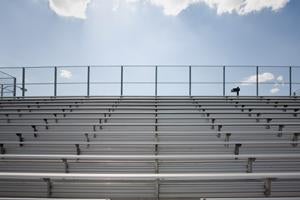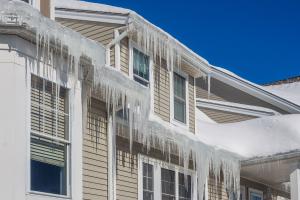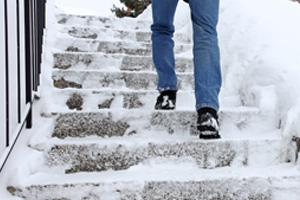Bleacher safety

Bleachers are a common feature for schools, especially those having competitive sports programs. While they come in many sizes and configurations, they typically fit into one of four categories according to the Consumer Product Safety Commission (CPSC): permanent/stationary, portable/movable, telescopic/folding, and temporary. Each year, thousands of bleacher-related incidents lead to emergency room visits and, sadly, sometimes result in fatalities. Many of these incidents involve falls from bleachers onto a surface below.
The following guidelines are based on CPSC recommendations developed after a comprehensive review in response to multiple fatalities and serious injuries involving children using bleachers. In addition to these recommendations, it would be prudent to consult with experts in local building codes as well as to inspect the bleachers to ensure they meet safety guidelines and are maintained in good condition
Chief among safety concerns involving bleachers is falling off bleachers and falling through openings in them.
Steps to help prevent falls from bleachers
- Provide guardrails where the height of the bleachers’ footboard, seat board, or aisle is 30 inches or more above the floor or ground.
- Guardrails should be at least 42 inches above the leading edge of the adjacent footboard, seat board, or aisle.
- Guardrails should prevent the passage of a 4-inch sphere, which represents the approximate size of a baby’s head.
- Favor picket fence (vertical) guardrail designs as they discourage children from climbing over them.
- If in-fill guardrail members allow footholds, limit maximum openings to 1.75 inches.
- If the bleachers are against a wall as high as the guardrail height recommended, a guardrail is not needed if space between the bleachers and wall will not allow passage of a 4-inch sphere.
Guidelines to help prevent falls through bleachers
- The 4-inch sphere concept also applies to risers protecting the space above footboards and below seat boards, where the footboard is 30 inches or greater above the ground or floor.
- According to the CPSC, rigid materials should be used to close openings between seating components, rather than chain link or other fencing material.
Bleacher inspection and maintenance best practices
- Per the CPSC, bleachers should be inspected at least quarterly and any problems noted should be remedied immediately.
- A qualified person or firm should inspect bleachers every two years at minimum and provide a written “fit for use” certification at that time.
- Records of inspections and any maintenance should be maintained.
- If the structure is undergoing a retrofit, consider adding non-skid surfaces, handrails, aisles, and other features that may assist in accessibility and egress.
Material on this page derived from the U.S. CPSC’s Guidelines for Retrofitting Bleachers which can be found at https://www.cpsc.gov/s3fs-public/330.pdf for more information.
This material is provided for informational purposes only and does not provide any coverage or guarantee loss prevention. The examples in this material are provided as hypothetical and for illustration purposes only. The Hanover Insurance Company and its affiliates and subsidiaries (“The Hanover”) specifically disclaim any warranty or representation that acceptance of any recommendations contained herein will make any premises, or operation safe or in compliance with any law or regulation. By providing this information to you. The Hanover does not assume (and specifically disclaims) any duty, undertaking or responsibility to you. The decision to accept or implement any recommendation(s) or advice contained in this material must be made by you.
Related resources
Bleacher safety
Bleachers are a common feature for schools, especially those having competitive sports programs. While they come in many sizes and configurations, they typically fit into one of four categories according to the Consumer Product Safety Commission (CPSC): permanent/stationary, portable/movable, telescopic/folding, and temporary. Each year, thousands of bleacher-related incidents lead to emergency room visits and, sadly, sometimes result in fatalities. Many of these incidents involve falls from bleachers onto a surface below.
The following guidelines are based on CPSC recommendations developed after a comprehensive review in response to multiple fatalities and serious injuries involving children using bleachers. In addition to these recommendations, it would be prudent to consult with experts in local building codes as well as to inspect the bleachers to ensure they meet safety guidelines and are maintained in good condition
Chief among safety concerns involving bleachers is falling off bleachers and falling through openings in them.
Steps to help prevent falls from bleachers
- Provide guardrails where the height of the bleachers’ footboard, seat board, or aisle is 30 inches or more above the floor or ground.
- Guardrails should be at least 42 inches above the leading edge of the adjacent footboard, seat board, or aisle.
- Guardrails should prevent the passage of a 4-inch sphere, which represents the approximate size of a baby’s head.
- Favor picket fence (vertical) guardrail designs as they discourage children from climbing over them.
- If in-fill guardrail members allow footholds, limit maximum openings to 1.75 inches.
- If the bleachers are against a wall as high as the guardrail height recommended, a guardrail is not needed if space between the bleachers and wall will not allow passage of a 4-inch sphere.
Guidelines to help prevent falls through bleachers
- The 4-inch sphere concept also applies to risers protecting the space above footboards and below seat boards, where the footboard is 30 inches or greater above the ground or floor.
- According to the CPSC, rigid materials should be used to close openings between seating components, rather than chain link or other fencing material.
Bleacher inspection and maintenance best practices
- Per the CPSC, bleachers should be inspected at least quarterly and any problems noted should be remedied immediately.
- A qualified person or firm should inspect bleachers every two years at minimum and provide a written “fit for use” certification at that time.
- Records of inspections and any maintenance should be maintained.
- If the structure is undergoing a retrofit, consider adding non-skid surfaces, handrails, aisles, and other features that may assist in accessibility and egress.
Material on this page derived from the U.S. CPSC’s Guidelines for Retrofitting Bleachers which can be found at https://www.cpsc.gov/s3fs-public/330.pdf for more information.
This material is provided for informational purposes only and does not provide any coverage or guarantee loss prevention. The examples in this material are provided as hypothetical and for illustration purposes only. The Hanover Insurance Company and its affiliates and subsidiaries (“The Hanover”) specifically disclaim any warranty or representation that acceptance of any recommendations contained herein will make any premises, or operation safe or in compliance with any law or regulation. By providing this information to you. The Hanover does not assume (and specifically disclaims) any duty, undertaking or responsibility to you. The decision to accept or implement any recommendation(s) or advice contained in this material must be made by you.
Related resources
Bleacher safety
Bleachers are a common feature for schools, especially those having competitive sports programs. While they come in many sizes and configurations, they typically fit into one of four categories according to the Consumer Product Safety Commission (CPSC): permanent/stationary, portable/movable, telescopic/folding, and temporary. Each year, thousands of bleacher-related incidents lead to emergency room visits and, sadly, sometimes result in fatalities. Many of these incidents involve falls from bleachers onto a surface below.
The following guidelines are based on CPSC recommendations developed after a comprehensive review in response to multiple fatalities and serious injuries involving children using bleachers. In addition to these recommendations, it would be prudent to consult with experts in local building codes as well as to inspect the bleachers to ensure they meet safety guidelines and are maintained in good condition
Chief among safety concerns involving bleachers is falling off bleachers and falling through openings in them.
Steps to help prevent falls from bleachers
- Provide guardrails where the height of the bleachers’ footboard, seat board, or aisle is 30 inches or more above the floor or ground.
- Guardrails should be at least 42 inches above the leading edge of the adjacent footboard, seat board, or aisle.
- Guardrails should prevent the passage of a 4-inch sphere, which represents the approximate size of a baby’s head.
- Favor picket fence (vertical) guardrail designs as they discourage children from climbing over them.
- If in-fill guardrail members allow footholds, limit maximum openings to 1.75 inches.
- If the bleachers are against a wall as high as the guardrail height recommended, a guardrail is not needed if space between the bleachers and wall will not allow passage of a 4-inch sphere.
Guidelines to help prevent falls through bleachers
- The 4-inch sphere concept also applies to risers protecting the space above footboards and below seat boards, where the footboard is 30 inches or greater above the ground or floor.
- According to the CPSC, rigid materials should be used to close openings between seating components, rather than chain link or other fencing material.
Bleacher inspection and maintenance best practices
- Per the CPSC, bleachers should be inspected at least quarterly and any problems noted should be remedied immediately.
- A qualified person or firm should inspect bleachers every two years at minimum and provide a written “fit for use” certification at that time.
- Records of inspections and any maintenance should be maintained.
- If the structure is undergoing a retrofit, consider adding non-skid surfaces, handrails, aisles, and other features that may assist in accessibility and egress.
Material on this page derived from the U.S. CPSC’s Guidelines for Retrofitting Bleachers which can be found at https://www.cpsc.gov/s3fs-public/330.pdf for more information.
This material is provided for informational purposes only and does not provide any coverage or guarantee loss prevention. The examples in this material are provided as hypothetical and for illustration purposes only. The Hanover Insurance Company and its affiliates and subsidiaries (“The Hanover”) specifically disclaim any warranty or representation that acceptance of any recommendations contained herein will make any premises, or operation safe or in compliance with any law or regulation. By providing this information to you. The Hanover does not assume (and specifically disclaims) any duty, undertaking or responsibility to you. The decision to accept or implement any recommendation(s) or advice contained in this material must be made by you.
Related resources
Bleacher safety
Bleachers are a common feature for schools, especially those having competitive sports programs. While they come in many sizes and configurations, they typically fit into one of four categories according to the Consumer Product Safety Commission (CPSC): permanent/stationary, portable/movable, telescopic/folding, and temporary. Each year, thousands of bleacher-related incidents lead to emergency room visits and, sadly, sometimes result in fatalities. Many of these incidents involve falls from bleachers onto a surface below.
The following guidelines are based on CPSC recommendations developed after a comprehensive review in response to multiple fatalities and serious injuries involving children using bleachers. In addition to these recommendations, it would be prudent to consult with experts in local building codes as well as to inspect the bleachers to ensure they meet safety guidelines and are maintained in good condition
Chief among safety concerns involving bleachers is falling off bleachers and falling through openings in them.
Steps to help prevent falls from bleachers
- Provide guardrails where the height of the bleachers’ footboard, seat board, or aisle is 30 inches or more above the floor or ground.
- Guardrails should be at least 42 inches above the leading edge of the adjacent footboard, seat board, or aisle.
- Guardrails should prevent the passage of a 4-inch sphere, which represents the approximate size of a baby’s head.
- Favor picket fence (vertical) guardrail designs as they discourage children from climbing over them.
- If in-fill guardrail members allow footholds, limit maximum openings to 1.75 inches.
- If the bleachers are against a wall as high as the guardrail height recommended, a guardrail is not needed if space between the bleachers and wall will not allow passage of a 4-inch sphere.
Guidelines to help prevent falls through bleachers
- The 4-inch sphere concept also applies to risers protecting the space above footboards and below seat boards, where the footboard is 30 inches or greater above the ground or floor.
- According to the CPSC, rigid materials should be used to close openings between seating components, rather than chain link or other fencing material.
Bleacher inspection and maintenance best practices
- Per the CPSC, bleachers should be inspected at least quarterly and any problems noted should be remedied immediately.
- A qualified person or firm should inspect bleachers every two years at minimum and provide a written “fit for use” certification at that time.
- Records of inspections and any maintenance should be maintained.
- If the structure is undergoing a retrofit, consider adding non-skid surfaces, handrails, aisles, and other features that may assist in accessibility and egress.
Material on this page derived from the U.S. CPSC’s Guidelines for Retrofitting Bleachers which can be found at https://www.cpsc.gov/s3fs-public/330.pdf for more information.
This material is provided for informational purposes only and does not provide any coverage or guarantee loss prevention. The examples in this material are provided as hypothetical and for illustration purposes only. The Hanover Insurance Company and its affiliates and subsidiaries (“The Hanover”) specifically disclaim any warranty or representation that acceptance of any recommendations contained herein will make any premises, or operation safe or in compliance with any law or regulation. By providing this information to you. The Hanover does not assume (and specifically disclaims) any duty, undertaking or responsibility to you. The decision to accept or implement any recommendation(s) or advice contained in this material must be made by you.





